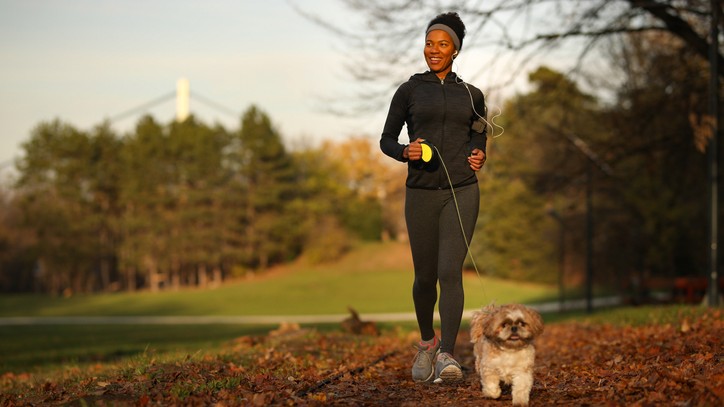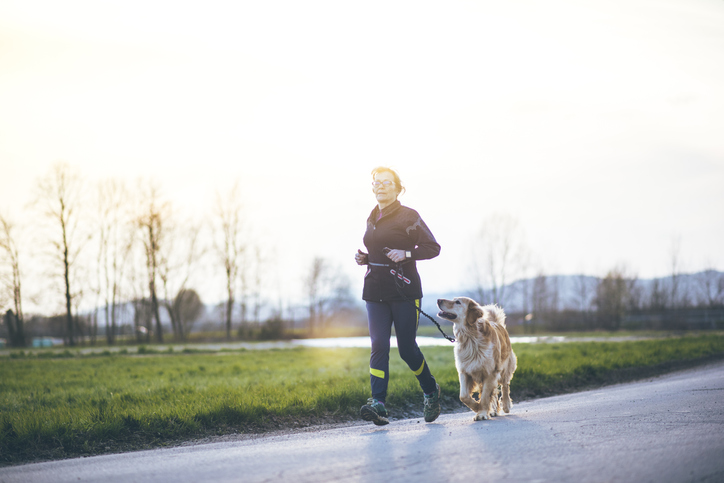10 tips for running with your dog
Our top tips for running with your dog will have you confidently pounding the pavement together in no time

There’s never been a better time to take up running with your dog, with the Coronavirus pandemic causing a surge in dog ownership around the globe and more and more people exercising outdoors instead of at the gym.
Running can have huge physical and mental health benefits for both you and your furkid, and if you happen to have one of the best dogs for runners, it’s a great way to strengthen your bond with your canine companion by spending some quality time together. It can do wonders for both your dog's wellbeing and yours, and the different sights and smells your dog will experience along the way provide them with the mental enrichment and stimulation they need.
If you’re looking to turn man’s best friend into man’s best running companion, then we’ve got you covered with our top 10 tips for running with your dog that will ensure your precious pooch stays safe and comfortable at all times.
- Best dry dog food: Which brand of dry food is king of the kibble?
- Best large dog bed: give your big friend maximum comfort
- Best dog toys: Six options to keep your pet pooch amused
1. Consider your dog’s breed, health and age
Before you start any running program, make sure your dog is a suitable candidate. If your furry friend is a flat-faced breed, such as a pug or bulldog, running is likely to be too taxing on them. Their narrowed nostrils and partially obstructed airways can make breathing challenging, so walking is preferable. Dogs with short legs may struggle to keep up with a fast pace, and larger breeds can be prone to hip dysplasia, which can cause arthritis and make running uncomfortable.
When it comes to puppies, wait until your young canine companion's bones and joints have fully formed before you start running together, as hard surfaces can cause damage to their delicate musculoskeletal system. While the time this takes varies from breed to breed, 18 months will be a suitable age for most puppies to pound the pavement with you. At the older end of the spectrum, senior dogs in good shape may still enjoy running but for those with joint and mobility issues, a gentle walk is best.
2. Walk before you run
While it can be tempting to hit the ground running the minute your furkid is old enough, training them to master walking on a lead first will ensure that running together is safe for both you and them. Any environment you’re in is going to be full of distractions, such as new noises, smells, and other animals, so training your dog to walk nicely beside you without pulling the lead or stopping every few seconds to sniff something is important.
You’ll also want to ensure they can follow commands such as ‘leave it’, ‘sit’ and ‘stay’. This will help them avoid any tempting items they spot while running and will make sure they stop when you need them to, such as near busy roads. Keeping a stash of the best dog treats in your pocket while leash training your pup can be a great way of rewarding them for doing what you’ve asked and rewarding positive behavior.
Get the best advice, tips and top tech for your beloved Pets
3. Start slowly and build up
Can you imagine waking up one day after never running before and having someone take you out on a 5-mile run? Talk about a nightmare! Just like humans, dogs need time to build up the ability to run for long periods. Too much running too soon won’t just exhaust them, it can also increase the risk of injury. Try interval training for the first several weeks, interspersing periods of running with periods of walking so that your pup has plenty of time to recover and catch their breath. Make sure you always do a warm-up with your dog before you exercise with them, so their muscles are ready to run.
4. Invest in the right kit
Just like you need to put thought into your running attire, your dog needs to be kitted out correctly too. During the colder months, choosing the best dog coat can help keep your furkid warm and dry while they run. Many of these have reflective strips on them, making them perfect for those dawn or dusk training sessions when visibility isn’t as good. Footwear is worth considering if you’re going to be hitting the trails, and there are some brilliant options out there that have been specially designed for running.
When choosing a harness or collar, look for an option that won’t restrict your dog’s natural movements or be harsh on their neck. And if you’re serious about improving your dog’s fitness and keeping track of their activity levels, then investing in one of the best pet trackers can help you do just that. As a bonus, many of these come with GPS tracking so you can locate your dog easily if you get separated.
5. Protect against ticks
Time in the great outdoors means more time where your dog is at risk of picking up ticks along the way. Many of the best flea treatments on the market do a great job of offering protection against both fleas and ticks, if you’re not sure what one to use, ask your dog’s vet, who will be able to offer advice. Give your furkid a good checking over when you get home to make sure no little critters have hitched a ride in their coat, especially if you’ve been running through the woods or long grass.

6. Choose a paw-friendly route
Your pooch’s paws are tender and need to be well cared for if they’re going to be running regularly. If running with bare paws, choose a route that is largely free from rocks and uneven terrain and avoid running on pavement that is likely to have been salted, as this can make your dog unwell if they lick their paws once inside. In the summer, hot surfaces should be avoided as these can burn your dog’s feet.
The best way to protect your furkid if you’re wanting to trail run or pound the pavement on a hot summer day is to invest in a pair of booties. If they’re not a fan of wearing these, then applying a layer of petroleum jelly can act as a shield against irritants. Make sure you also keep your dog’s nails trimmed to make running more comfortable; our guide to the best dog nail clippers can help you select the right pair for your dog’s size.
7. Check the weather conditions
If you’re a dedicated runner, you’re likely used to running in all sorts of weather conditions, but this may not be ideal for your dog. Extreme weather can be problematic, with high temperatures putting your furkid at risk of overheating. Many dogs have thick coats, and they’re also unable to sweat, so avoid exercising during the hottest parts of the day and try running in the shade where possible.
Keep an eye on cold weather too, and when the temperatures drop ensure your pup is dressed warmly to decrease the risk of hypothermia and frostbite and opt for shorter runs.
8. Stay hydrated
Unlike humans, most dogs won’t need to refuel on a long run, but they will need to stay well hydrated. Because your dog can’t tell you when they’re thirsty and will continue to run even when they become dehydrated, stopping regularly and offering water is the best way to ensure they get the fluid they need. Carry a collapsible dog bowl with you; most of these have carabiner clips for easy portability or look for a drinking bottle that has a spout designed for dogs.
9. Watch for warning signs
Monitor your furkid while you run for any signs of overexertion or discomfort. Things to watch out for include lethargy, weakness, drooling, a dark red tongue or gums, vomiting or panting to the point where your dog is unable to breathe properly. These are all signs of exhaustion that require an immediate break.
Find a cool place for your dog to lie down and give them small portions of water, enough to rehydrate them but not enough that they’ll gulp down too much and suffer from water toxicity. If they feel particularly hot, pouring some water over their head can help to cool them down and get their body temperature back to normal.
10. Check in with your vet
Even if you’re confident your dog is a natural-born runner, checking in with your vet can give you peace of mind that you’ve thought of everything. Your dog’s vet can give them a quick health check to make sure they’re in tip-top shape and can draw your attention to anything you need to be mindful of. They can also advise you on any dietary changes that may be needed as the frequency and duration of your dog's exercise increases.

Kathryn is a freelance writer who has been a member of the PetsRadar family since it launched in 2020. Highly experienced in her field, she's driven by a desire to provide pet parents with accurate, timely, and informative content that enables them to provide their fur friends with everything they need to thrive.
Kathryn works closely with vets and trainers to ensure all articles offer the most up-to-date information across a range of pet-related fields, from insights into health and behavior issues to tips on products and training.
When she’s not busy crafting the perfect sentence for her features, buying guides and news pieces, she can be found hanging out with her family (which includes one super sassy cat and a kitten), drinking copious amounts of Jasmine tea and reading all the books.
She has written for a range of publications, including Fit&Well, Top Ten Reviews, LiveScience, Goodto, and Product Hunt.
